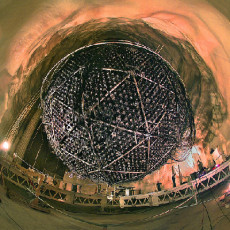Historic Sudbury Neutrino Observatory Data, Carried by ESnet, Lives on at NERSC
January 26, 2010
Contact: Linda Vu, lvu@lbl.gov, +1 510 486 2402

SNO onsists of an 18-meters-in-diameter stainless steel geodesic sphere inside of which is an acrylic vessel filled with 1000 tons of heavy water (deuterium oxide or D2O). Attached to the sphere are 9,522 ultra-sensitive light-sensors called photomultiplier tubes. When neutrinos passing through the heavy water interact with deuterium nuclei, flashes of light are emitted. The photomultiplier tubes detect these light flashes and convert them into electronic signals that scientists can analyze for the presence of all three types of neutrinos. (Credit: Photo by Roy Kaltschmidt)
Tunneled 6,800 feet underground in Canada's Vale Inco Creighton mine, the Sudbury Neutrino Observatory (SNO) was designed to detect neutrinos produced by fusion reactions in the Sun. Although the observatory officially "switched off" in August 2006, a copy of all the data generated for and by the experiment will live on at the National Energy Research Scientific Computing Center (NERSC).
"NERSC has been providing great support to SNO for over a decade. We used the PDSF cluster do some of the early analyses and were really appreciative of the support that we received from NERSC staff. When we looked around at different facilities and talked to colleagues that have used the center's High Performance Storage System [HPSS] extensively, we immediately concluded that one copy of our data should be stored at NERSC," says Alan Poon, a member of the SNO collaboration at the Lawrence Berkeley National Laboratory (Berkeley Lab).
"The Department of Energy invested a lot of resources into SNO, and we believe that preserving these datasets at NERSC will afford the best protection of the agency's investment," he adds.
According to Poon, the SNO experiment has made tremendous contributions to humanity's understanding of neutrinos, invisible elementary particles that permeate the cosmos. Before the observatory started searching for solar neutrinos on Earth, all experiments up to that point detected only a fraction of the particles predicted to exist by detailed theories of energy production in the Sun. Results from the SNO experiment eventually revealed that the total number of neutrinos produced in the Sun is just as predicted by solar models, but the neutrinos are oscillating in transit, changing in type or "flavor" from electron neutrinos (the flavor produced in the Sun) to muon or tau neutrinos. In 2001, Science Magazine identified SNO’s solution to the solar neutrino mystery as one of their 10 science breakthroughs of the year.
"SNO data will be unique for decades to come. There will not be another experiment in the foreseeable future that would provide the same measurement with better precision and accuracy," says Ryan Martin, a postdoctoral researcher at the Berkeley Lab who helped migrate data from disks at the SNO facility in Sudbury, Canada, to the NERSC facility in Oakland, Calif. "It is important to preserve this data for the scientific community, in case a new theory would require further studies of the data."
Martin worked closely with Damian Hazen of NERSC's Storage Systems Group to transfer 26 terabytes of data across the DOE's Energy Sciences Network (ESnet) to NERSC's HPSS. This set includes everything from the raw data generated by the experiment and processed data used during analysis to the computer codes and simulations used for detector design and scientific computation.
"From testing the transfer speed, tuning the network and identifying packet losses, to the final archiving at HPSS, the center's expertise saved us a lot of headache," says Martin. "These are technical issues that laymen like us would take a long time to solve, if at all. We have been really pleased with the help that NERSC staff have provided."
For more information about SNO, please visit:
http://newscenter.lbl.gov/feature-stories/2003/09/23/a-dash-of-salt-enhances-sno-results/
For more information about Computing Sciences at Berkeley Lab, please visit:
http://www.lbl.gov/cs
About NERSC and Berkeley Lab
The National Energy Research Scientific Computing Center (NERSC) is a U.S. Department of Energy Office of Science User Facility that serves as the primary high performance computing center for scientific research sponsored by the Office of Science. Located at Lawrence Berkeley National Laboratory, NERSC serves almost 10,000 scientists at national laboratories and universities researching a wide range of problems in climate, fusion energy, materials science, physics, chemistry, computational biology, and other disciplines. Berkeley Lab is a DOE national laboratory located in Berkeley, California. It conducts unclassified scientific research and is managed by the University of California for the U.S. Department of Energy. »Learn more about computing sciences at Berkeley Lab.







